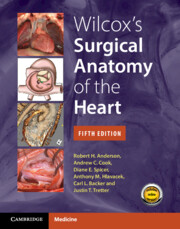952 results
The contribution of cannabis use to the increased psychosis risk among minority ethnic groups in Europe
-
- Journal:
- Psychological Medicine , First View
- Published online by Cambridge University Press:
- 09 May 2024, pp. 1-10
-
- Article
-
- You have access
- Open access
- HTML
- Export citation
9 - Lesions in Hearts with Abnormal Segmental Connections
-
- Book:
- Wilcox's Surgical Anatomy of the Heart
- Published online:
- 10 April 2024
- Print publication:
- 02 May 2024, pp 299-406
-
- Chapter
- Export citation
8 - Lesions with Normal Segmental Connections
-
- Book:
- Wilcox's Surgical Anatomy of the Heart
- Published online:
- 10 April 2024
- Print publication:
- 02 May 2024, pp 175-298
-
- Chapter
- Export citation
Chapter 4 - Surgical Anatomy of the Valves of the Heart
-
- Book:
- Wilcox's Surgical Anatomy of the Heart
- Published online:
- 10 April 2024
- Print publication:
- 02 May 2024, pp 77-112
-
- Chapter
- Export citation
Chapter 11 - Positional Anomalies of the Heart
-
- Book:
- Wilcox's Surgical Anatomy of the Heart
- Published online:
- 10 April 2024
- Print publication:
- 02 May 2024, pp 465-477
-
- Chapter
- Export citation
Copyright page
-
- Book:
- Wilcox's Surgical Anatomy of the Heart
- Published online:
- 10 April 2024
- Print publication:
- 02 May 2024, pp iv-iv
-
- Chapter
- Export citation
Acknowledgements
-
- Book:
- Wilcox's Surgical Anatomy of the Heart
- Published online:
- 10 April 2024
- Print publication:
- 02 May 2024, pp viii-viii
-
- Chapter
- Export citation
Chapter 7 - Analytic Description of Congenitally Malformed Hearts
-
- Book:
- Wilcox's Surgical Anatomy of the Heart
- Published online:
- 10 April 2024
- Print publication:
- 02 May 2024, pp 153-174
-
- Chapter
- Export citation
Chapter 5 - Surgical Anatomy of the Coronary Circulation
-
- Book:
- Wilcox's Surgical Anatomy of the Heart
- Published online:
- 10 April 2024
- Print publication:
- 02 May 2024, pp 113-132
-
- Chapter
- Export citation
Chapter 1 - Surgical Approaches to the Heart
-
- Book:
- Wilcox's Surgical Anatomy of the Heart
- Published online:
- 10 April 2024
- Print publication:
- 02 May 2024, pp 1-10
-
- Chapter
- Export citation
Index
-
- Book:
- Wilcox's Surgical Anatomy of the Heart
- Published online:
- 10 April 2024
- Print publication:
- 02 May 2024, pp 478-482
-
- Chapter
- Export citation
Preface
-
- Book:
- Wilcox's Surgical Anatomy of the Heart
- Published online:
- 10 April 2024
- Print publication:
- 02 May 2024, pp vii-vii
-
- Chapter
- Export citation
Contents
-
- Book:
- Wilcox's Surgical Anatomy of the Heart
- Published online:
- 10 April 2024
- Print publication:
- 02 May 2024, pp v-vi
-
- Chapter
- Export citation
Chapter 3 - Anatomy of the Cardiac Chambers
-
- Book:
- Wilcox's Surgical Anatomy of the Heart
- Published online:
- 10 April 2024
- Print publication:
- 02 May 2024, pp 41-76
-
- Chapter
- Export citation
Chapter 6 - Surgical Anatomy of Cardiac Conduction
-
- Book:
- Wilcox's Surgical Anatomy of the Heart
- Published online:
- 10 April 2024
- Print publication:
- 02 May 2024, pp 133-152
-
- Chapter
- Export citation
10 - Abnormalities of the Great Vessels
-
- Book:
- Wilcox's Surgical Anatomy of the Heart
- Published online:
- 10 April 2024
- Print publication:
- 02 May 2024, pp 407-464
-
- Chapter
- Export citation
The equitable impact of sugary drink taxation structures on sugary drink consumption among Canadians: a modelling study using the 2015 Canadian Community Health Survey-Nutrition
-
- Journal:
- Public Health Nutrition / Volume 27 / Issue 1 / 2024
- Published online by Cambridge University Press:
- 15 April 2024, e121
-
- Article
-
- You have access
- Open access
- HTML
- Export citation
The effect of psychiatric decision unit services on inpatient admissions and mental health presentations in emergency departments: an interrupted time series analysis from two cities and one rural area in England – CORRIGENDUM
-
- Journal:
- Epidemiology and Psychiatric Sciences / Volume 33 / 2024
- Published online by Cambridge University Press:
- 12 April 2024, e24
-
- Article
-
- You have access
- Open access
- HTML
- Export citation

Wilcox's Surgical Anatomy of the Heart
-
- Published online:
- 10 April 2024
- Print publication:
- 02 May 2024
546 Using Contingency Management to Understand the Cardiovascular, Immune and Psychosocial Benefits of Reduced Cocaine Use: A Protocol for a Randomized Controlled Trial
- Part of
-
- Journal:
- Journal of Clinical and Translational Science / Volume 8 / Issue s1 / April 2024
- Published online by Cambridge University Press:
- 03 April 2024, p. 163
-
- Article
-
- You have access
- Open access
- Export citation

